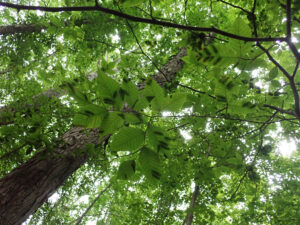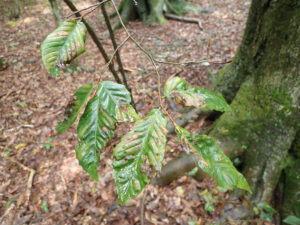By Kyoko Scanlon, DNR Forest Pathologist, Fitchburg;
Kyoko.Scanlon@wisconsin.gov or 608-235-7532
Forest owners and land managers should look for beech leaf disease (BLD) this summer, a destructive beech tree disease in the United States.
The disease is primarily found on American beech (Fagus grandifolia) but can also be found on ornamental species such as European, Oriental and Chinese beech (F. sylvatica, F. orientalis and F. engleriana). Although it has not yet been found in Wisconsin, recent discoveries of the disease in Michigan and other nearby states highlight the continued importance of monitoring BLD’s expansion. There is potential for BLD to move into Wisconsin as the eastern portion of the state overlaps with the native range of American beech.

Symptomatic striping from beech leaf disease, seen from under the canopy. / Photo Credit: Wisconsin DNR (taken in Cleveland, Ohio)
Symptomatic American beech trees were first found in Lake County, Ohio, in 2012. Since 2012, the disease has been detected in Connecticut, Delaware, Maine, Maryland, Massachusetts, Michigan, New Hampshire, New Jersey, New York, Pennsylvania, Rhode Island, Vermont, Virginia, West Virginia and the Canadian province of Ontario.
Symptomatic trees can be identified by dark striping or banding between leaf veins on multiple tree leaves. Striping is most easily spotted from the underside of the leaves while looking up into the canopy. More severe symptoms include leaf distortion, such as curling, puckering, thickening and the development of a leathery texture or necrotic (dead) leaf tissue. Other symptoms include aborted buds, branch and tip dieback, and premature leaf drop, which leads to a thinning canopy.
Smaller beeches are the most susceptible; however, tree mortality has been observed in all age classes within two to seven years.
Recent research has identified Litylenchus crenatae mccannii, a newly described nematode, as a necessary condition for symptom development. While the infection mechanism is not fully understood, the nematode is known to be associated with the leaves and buds of beech trees. The nematodes overwinter in buds and may be found in leaf tissue beginning in June or July.
Symptom detection may not be possible for some time after infestation; however, early detection techniques through molecular methods and infrared technologies are progressing. Difficulty in detection means that BLD may become established before symptomatic trees are discovered, such as in Michigan.

More severe beech leaf disease symptoms include thickening, puckering and chlorosis. / Photo Credit: Wisconsin DNR, taken in Cleveland, Ohio
In 2023, bud samples were collected throughout eastern Wisconsin, where American beech is distributed. The Plant and Pest Diagnostic Lab at Purdue University tested the samples for the DNA of Litylenchus crenatae mccannii. The DNA of Litylenchus crenatae mccannii was not detected in any of the 100 samples submitted in 2023. This survey will continue in 2024 and 2025.
Beech trees are an important part of our forests for many reasons, including providing food for wildlife. If you see symptoms of beech leaf disease in Wisconsin, please contact your regional forest health specialist.
Beech trees are important in our forests for many reasons, including providing food for wildlife. If you see symptoms of beech leaf disease in Wisconsin, please contact your regional forest health specialist.
